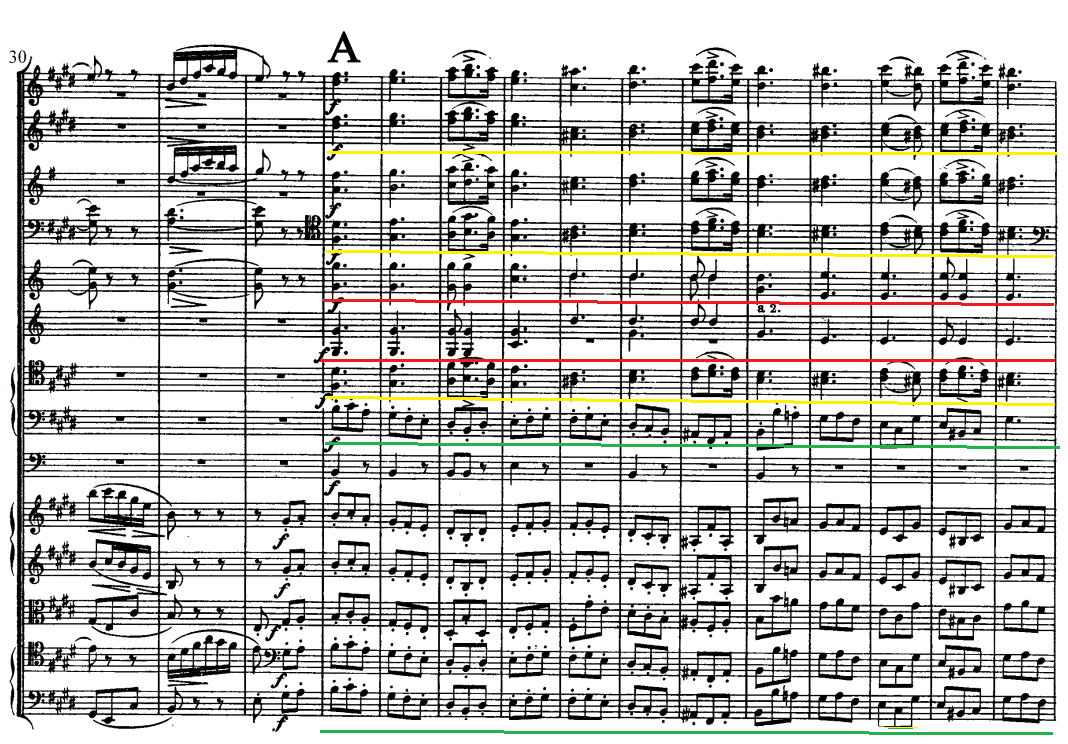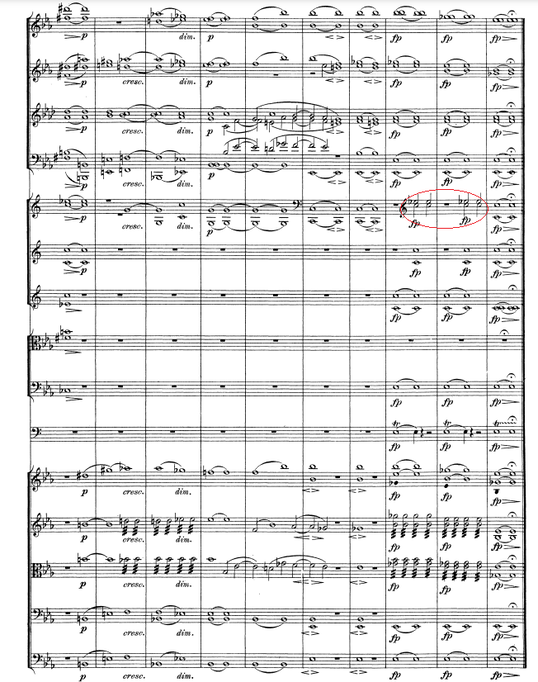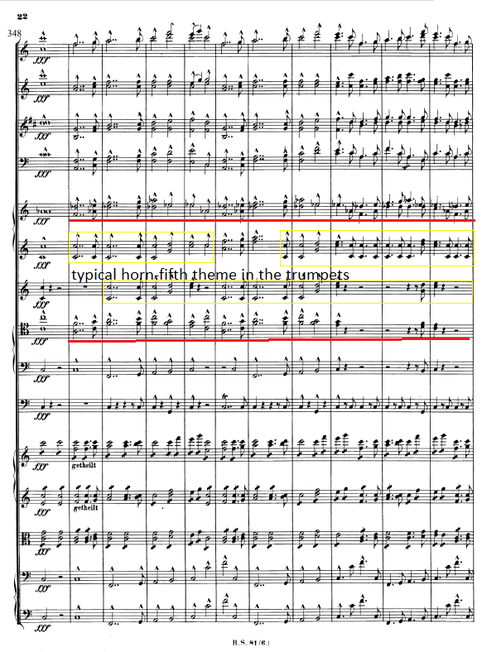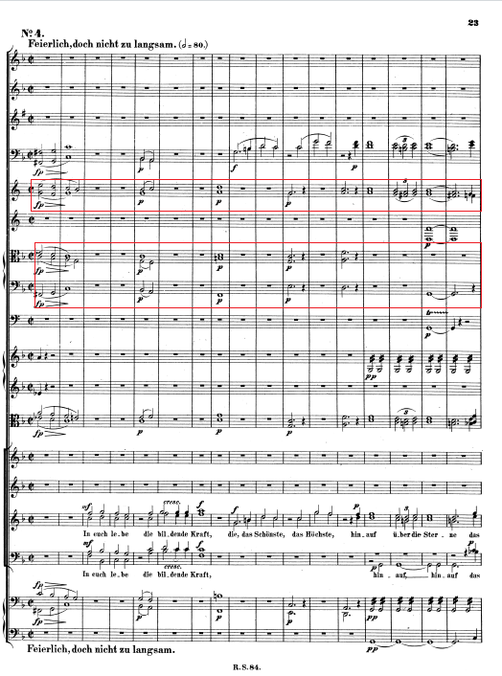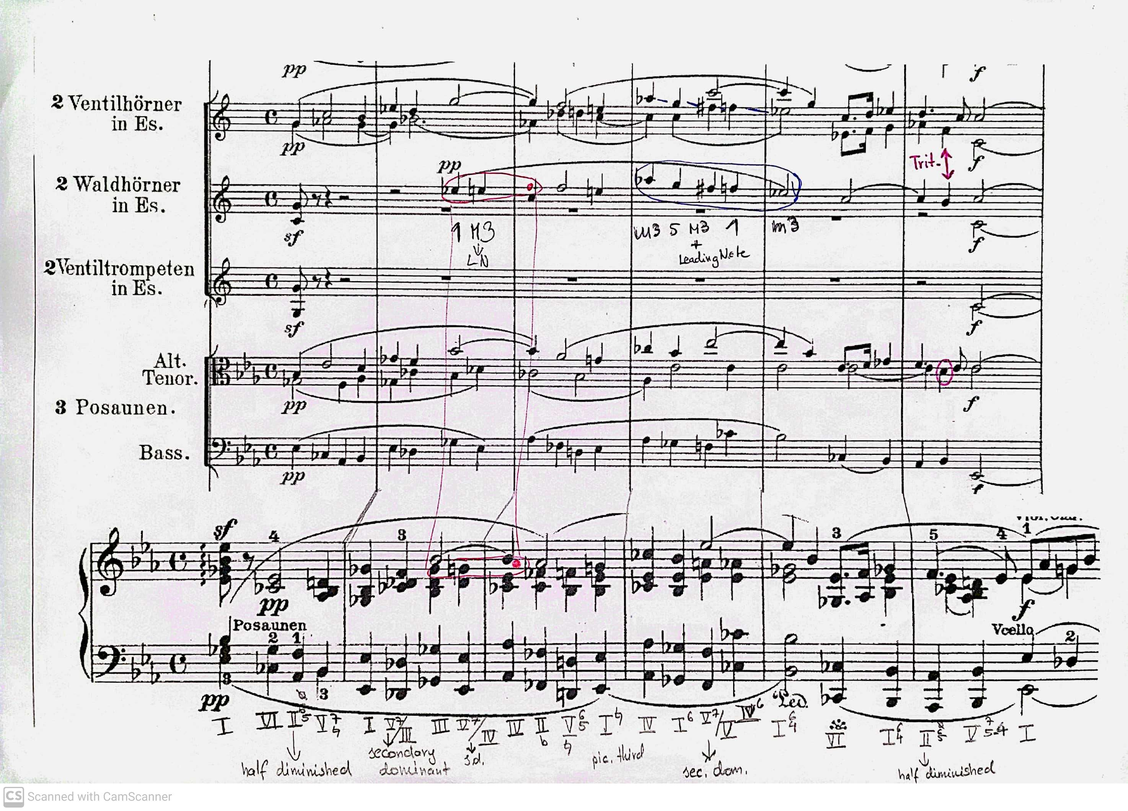The three important moments in this excerpt for the first Waldhorn in Es:
-
End of the second bar: the voice enters on the ground note of the harmony, sounding Gb, but it is closed and when the instrument changes to the next note, sounding G, it ‘opens suddenly the door’ to the third of the secondary dominant of the IV - Ab minor.
-
Fourth and fifth bar: here we can find a descending line Cb’-B’-A’-Ab’. The first two notes are played by the soprano voices, and the last two by the alto, except the third horn, which plays as it is, and makes a beautiful atmosphere with the different characters.
It starts with the closed Cb which is the (minor) third of the chord, then it opens to the fifth of the next one, then opens furthermore to the (major) third of the secondary dominant of the next chord, and suddenly closes back to the basic tone of the IV6 chord, and stays closed on the (minor) third of the I64. This path, from the closed sound to the widely open sound and then back to the closed, is also kind of a game with the emotions. The opening means the hope that we can leave the depressive and dark tonality, but it does not happen and we return back to the Eb minor. -
In the 6th bar: on the second beat, we have an Ab-D tritonus between the tenor and alto. Already in the classical era, the composers liked to make the tritonus more intensive with this closed sound; we can find the similar approach before the reprise in the Second Horn Concerto by W.A. Mozart
From this time, Schumann often used the two sections together, and not in the same way as we see in the Schubert symphony, but they played the same notes, the same melody etc. The importance of this is the fact that it became possible to use the horns better in passages like the beginning of the IV. movement of the Rheinisch Sinfonie; which we can take as a predecessor of the famous chorales for brass by Gustav Mahler or Anton Bruckner. Even though these examples, like the choral in the 5th movement in the 2nd Symphony, have a different character, they are also similar to this ‘original’ idea.
The movement is composed in a Bach choral style and the whole movement is built upon the first two bars. After the string’s sforzatopizzicato, that opens the movement, the horns and trombones continue with a completely different colour and texture. The symphony is in Eb major, but in this movement Schumann uses the minor version, which is an incredibly dark, painful, but majesty at the same time. The listener has a suppressed suffering and pain through the movement, but there is also the hope that everything will be better. Afterall the 5th movement has a more positive character.
Three horns and three trombones play in the excerpt, but it is more a choral for four voices. The bass trombone plays the bass, the second trombone the tenor, the second valve horn the alto part, and the first trombone and the first valve horn supports each other in the soprano. The sixth instrument, the first natural horn does not have any independent voice, except its first three notes. Mainly, it supports one of the other parts, highlights the modulations, or brings the attention to one specific line which is shared between more voices. Beside supporting one of the other parts, Schumann also plays with one of the most exciting skills of the natural horn, which does not come out too often in the orchestral parts, rather in the solo repertoire, but here he uses this to make the harmony changes more interesting. This is the chromatic playing, where every note has a different character and it makes the music livelier, and adds extra emotions to it.
The trombone was mostly used as a soloistic instrument in the orchestra for the majestic, and ceremonial passages, like the Chor der Priester in the Zauberflöte, Tuba mirum from Mozart’s Requiem. But I can mention the beginning of the 4th movement of Schumann’s Fourth Symphony. Also, in bigger tuttis, the trombone section was the one which give the sound for the melody, the horns and trumpets made the sound and made more powerful, and louder the actual musical segment, but mostly they played the tonic or the dominant, so the basic natural, and open notes. A good example for this is the 33rd bar in the second movement of the ‘Unfinished’ Symphony by Franz Schubert.
After the arrival of the valve horn this changed too. On many occasions the melody is not convincing enough on the natural horn, therefore I would say that Schumann would have written the passage for trombone if he wrote it 10 years earlier. One of these is the Allabreve in the Nachtlied op.108 where the register actually is doable on the natural horn, but the sound colour does not fit to the very soft woodwinds, and then I have not mentioned the next section a couple of bars later at Etwas bewegter where the melody would not sound as a calm and beautiful song from the distance, but more like a stressful animal that tries to get away from the hunters. With the valve horn’s and the flute’s duo, Schumann created such a wonderful, natural, relaxing, but still sparkling atmosphere, the likes of which the beginning of Gustav Mahler’s Titan Symphony.
After the beginning, this group has an important role, because each instrument always supports and gives extra sound to the voices, even though they are played by the woodwinds and strings too. It is a common pattern, that the bass trombone comes first, then the valve horns, because they can play open the lower notes too, then the natural horns in the register where even the stopped notes (B’, Eb”, F”) are not too disturbing and still audible, and then the first trombone.
The last noteworthy place front he movement are the second and third last bar. Here only the two valve horns play ‘against’ the orchestra. The minor third is kind of a last sigh, with the Ventilhorn, it is possible to play it dramatic, and not too direct, but still with an open sound.
From this part it is visible that the horn section has got the possibility to integrate more in the brass section, even if it sounds strange, and use it to its full potential. It became possible to use it in excerpts like the discussed one, or the Fourth movement in the Requiem für Mignon op.98b, the Langsam from the IV. Symphony,or the end of the Genoveva Overture, from bar 348 there is a huge orchestral tutti where except the trumpets and the natural horns all the brass instruments have melodic material.
